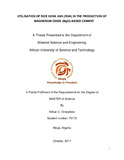| dc.description.abstract | The use of Magnesium oxide (MgO) cement as a full replacement and viable alternative for Ordinary Portland Cement was studied. Rice husk, an agricultural waste, was calcined and synthesised to be used as a source of silica and a pozzolan in the production of this cement. Rice husk ash (RHA) of various particle sizes (45, 106 and 150 μms) was used and varying dosages of superplasticiser were also used to alter the water to cement (w/c) ratio of the cement. The MgO/SiO 2 ratio at 60% MgO - 40% SiO 2 and different w/c ratio variations of 0.85, 0.89 and 0.93 were used to prepare a cement mortar in a cube mould of 50x50x50 mm according to ASTM C 109. The compressive strength of the cement, after a seven-day steam curing, when compared to Ordinary Portland Cement was 8.29 and 13.32 respectively. X-ray diffraction (XRD), X-ray Fluorescence Spectroscopy (XRF) and Fourier Transform Infrared Spectroscopy (FTIR) characterisation were carried out to determine the crystallinity of the RHA, the elemental composition of the MgO and the formation of M-S-H respectively. The RHA with finer particles gave the best w/c ratio when used as a form of silica and pozzolan in the M-S-H cement production and thus had the best compressive strength property. Curing of the M-S-H cement in steam was also seen to increase the compressive strength of the cement compared to curing in water. | en_US |

